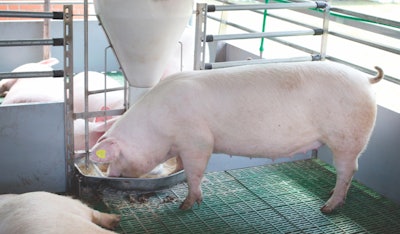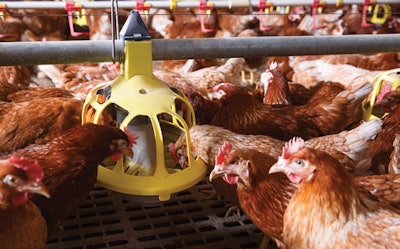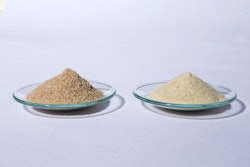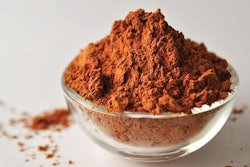
Enzymes and synthetic amino acid use are improving swine and poultry diet formulations, but questions remain on how to improve precision development and feed delivery.
The use of precision nutrition practices in swine and poultry production allows producers to reduce nutrient waste and feed cost while addressing environmental and production challenges.
Precision feeding lets producers provide feed with the right nutritional content and in the necessary amount, said Candido Pomar, a senior research scientist with Agriculture and Agri-Food Canada. His research in swine production and precision nutrition includes the development and use of mathematical modeling and precision feeding and farming systems.
Overall, the use of precision nutrition technologies with swine can bring several benefits, including reducing feeding and production costs by about 8%, allowing for more accurate planning on when to send pigs to slaughter and improving the environmental footprint of swine production, said Pomar. The precision approach can reduce nitrogen excretion by about 30% and is expected to improve as the system develops.
“Cost will be one benefit of using this technology, reducing nitrogen and phosphorus excretion is one (and) several groups are working with the early detection of diseases — that’s another benefit that you’re going to get,” he said.
Although there have been advances in how poultry and swine diets are formulated, including through the use of synthetic amino acids and enzymes, areas for development remain, said Michael Lilburn, professor emeritus of animal science at Ohio State University, and Chris Hostetler, director of animal science with the National Pork Board.
“Anything that producers can do to reduce the amount of feed … or the expense associated with feed is extremely important. It makes a critical contribution to their profitability as a business,” Hostetler added.
Ideal protein, environmental considerations
The ability to selectively add specific amino acids has changed diet formulations, said Lilburn. Lysine is now added in higher levels to support the production of broilers raised to generate more white meat.
The additives allow diets to be balanced using the ideal protein ratio, instead of focusing on individual amino acid levels, he said.
“From a precision standpoint, the use of the ideal protein ratio — all amino acids as a percentage of the lysine level — and the use of synthetic amino acids have probably been the biggest purely nutritional, formulation approaches that have changed,” he said.
Synthetic amino acid use and improved feed formulation software have altered ingredient use and diet complexity for swine producers, Hostetler added.
“Rather than just relying on soybean meal and the idea of crude protein in soybean meal, making up all of those amino acid needs … we can feed synthetic lysine and then we can reduce the amount of soybean meal,” he said.
Additionally, enzyme use decreases feed costs by boosting nutrient availability from feed ingredients and helps improve the environmental footprint of poultry production by limiting phosphorus excretion, said Lilburn. “For many years we used synthetic phosphorus in the diets and had tremendous excretion of phosphorus into the environment.”
Phosphorus in plant-based ingredients is bound in the form of phytic acid or phytate phosphorus and is not available for the bird to use, he said. However, enzymes, like phytase, can release the phosphorus and reduce the amount being excreted.
Enzyme use has expanded to address other nutritional elements, including breaking down starch and protein, Lilburn said.
Similarly, swine producers use enzymes to increase access to dietary nutrients, while reducing the amount being wasted, said Hostetler. “There are certain producers out there who have begun to think about how what they feed pigs impacts the environmental footprint of the way they raise pork,” he added.
In the future, looking at the production system holistically, there could be a point where pig diets are also optimized to help grow the crop that would be fertilized with manure from those animals, he said. “There are starting to be producers who are thinking in terms of how we change the ingredients and technologies that we use in our diet impacts our overall footprint.”
 Ongoing research is looking at how to transition diet formulation and delivery from focusing on a group of animals to pinpointing what is needed by individual animals in that herd or flock. (zlikovec | AdobeStock.com)
Ongoing research is looking at how to transition diet formulation and delivery from focusing on a group of animals to pinpointing what is needed by individual animals in that herd or flock. (zlikovec | AdobeStock.com)Ongoing research
One challenge to the implementation of focused nutrition for swine has been that feeds are designed for a group of pigs with ranging bodyweights and needs, said Pomar.
This prompted the creation of new models and feeders intended to feed commercially produced swine individually, he said.
The system developed uses a set of base feeds with varying nutritional contents that can be blended and delivered for each pig in the system, he said. The method allows diets to be designed so heavier pigs would receive a less nutritionally dense diet than smaller animals.
Larger companies in Europe are already moving toward the use of precision feeding practices, Pomar said. “They realize that adopting this technology is not just a matter of changing these feeders, the machines, and building another silo — it’s going to be much more complex — they have to change the way they are fabricating and formulating.”
The shift is part of a larger movement toward precision farming, he said. “I don’t see a company moving just to precision nutrition; I think it will be precision farming where precision nutrition will be an important part … the cost of producing the pig is the feed.”
The precision system and models were developed using available information like feed intake and behavior, said Pomar. As producers add new sensors, like automatic scales, the models used to “estimate nutrient profiles” will become more accurate.
The precision feed system also is intended to make some parts of the production process more automatic by using technology to follow pigs and observe how they eat and grow, he said. “The computer is going to decide from all the information we have, how they are going to blend the two feeds or the three feeds in some cases,” he added.
Feed distribution also would be automatic, and producers and nutritionists would have new roles to play in this type of facility, he said.
Formulating without antibiotics
Changing production practices, like the move toward antibiotic-free production, have introduced new challenges to feed efficiency for poultry producers and are prompting the use of new ingredients, said Lilburn.
The use of antibiotics helped reduce the overall microbial population in the gut and allowed birds to have better access to nutrients and be more efficient, he said. Removing them has reduced feed efficiency.
The shift is sparking interest in some feed additives like botanicals and organic acids, which are used in Europe, he said. However, questions remain regarding best practices for using those ingredients and how to measure their effectiveness.
Remaining question and what’s next
Currently, Pomar’s group is working to make the feeders it designed more automatic and to facilitate use in a commercial setting, he said. “They should be robust and not very expensive — that’s now the big challenge.”
Additionally, the system could provide a way to incorporate new or regional feed ingredients into diets, he said. “It’s a nice opportunity to look for ingredients that today we do not use in volume.”
“An old pig is able to eat a lot and we are not taking advantage of that ability,” he said. “With precision feeding, you’re opening the opportunity to use other feed ingredients, but this has to be developed — today we don’t know how to formulate these feeds with high fiber diets, or with some coproducts, so we have to develop that.”
Another area for additional research would be gestating sow diets, said Hostetler.
“I can really see a need as an industry to do an early gestation, mid-gestation and late-gestation diet and being able to have the technology and the feed handling systems to deliver that diet,” he said.
There also is interest in designing diets to meet the needs of disease-challenged swine, he said. New research seeking to understand how an animal’s nutritional needs change when it is sick or heat-stressed and what nutritional supports could be provided to help it recover faster is underway.













